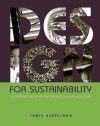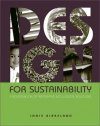![Design for Sustainability Design for Sustainability]()
Click to have a closer look
About this book
Contents
Customer reviews
Biography
Related titles
About this book
Presents radical and detailed examples of integrated systems design by many the foremost designers in the fields of industrial design, materials, housing design, urban planning and transport, landscape and permaculture, and energy and resource use. They cut across traditional boundaries to move towards a new transdisciplinary apprach to environmental and social problem solving.
Contents
Section 1 Designing Eco-solutions: 1.1 Education for Eco-innovation; 1.2 The Centrality of Design; 1.3 Green Philosophy; 1.4 Responsible Design Section 2 The Concepts of Growth and Waste: 2.1 Limits to Growth and Design of Settlements; 2.2 Redefining Progress; 2.3 Designing Waste; 2.4 Designing for Durability Section. Part 3 Industrial, Urban and Construction Ecology; 3.1 Industrial Ecology 3.2 Urban Ecology; 3.3 Construction Ecology; 3.4 Pollution Prevention by Design. Section 4 Design within Complex Social Systems: 4.1 Complexity and the Urban Environment; 4.2 Unified Human Community Ecology; 4.3 The Bionic Method in Industrial Design; 4.4 Green Theory in the Construction Fields. Section 5 Permaculture and Landscape Design: 5.1 Permaculture and Design Education; 5.2 The Sustainable Landscape; 5.3 Place, Community Values and Planning; 5.4 Playgardens and Community Development. Section 6 Values Embodied in and Reinforced by Design: 6.1 Urban Forms and the Dominant Paradigm; 6.2 Models of Ecological Housing; 6.3 Marketing-led Design; 6.4 Gender and Product Semantics. Section 7 Design for Community Building and Health: 7.1 ESD and 'Sense of Community'; 7.2 Sustainability and Aboriginal Housing; 7.3 Indoor Air Quality in Housing; 7.4 Beyond the Chemical Barrier. Section 8 Productivity, Land and Transport Efficiency: 8.1 Greening the Workplace; 8.2 Sustainable Personal Urban Transport; 8.3 From Sub-urbanism to Eco-cities; 8.4 Density, Environment and the City. Section 9 Design with Less Energy Materials and Waste: 9.1 Living Technologies; 9.2 Housing Wastewater Solutions; 9.3 Autonomous Servicing; 9.4 Timber Waste Minimisation by Design. Section 10 Low-impact Housing Design and Materials: 10.1 Earth Building; 10.2 Strawbale Construction; 10.3 Bamboo as a Building Resource; 10.4 Hemp Architecture. Section 11 Construction and Environmental Regulation; 11.1 Legislative Environmental Controls; 11.2 Economic Instruments; 11.3 Building Codes and Sustainability; 11.4 Assessing Building Materials. Section 12 Planning and Project Assessment: 12.1 Planning for Ecological Sustainability; 12.2 Bioregional Planning; 12.3 Environmental Management Tools; 12.4 Limits of Environmental Impact Assessment.
Customer Reviews
Biography
Janis Birkeland is Director of the Centre for Environmental Philosophy and Lecturer in the Architecture Department at the University of Canberra.



































